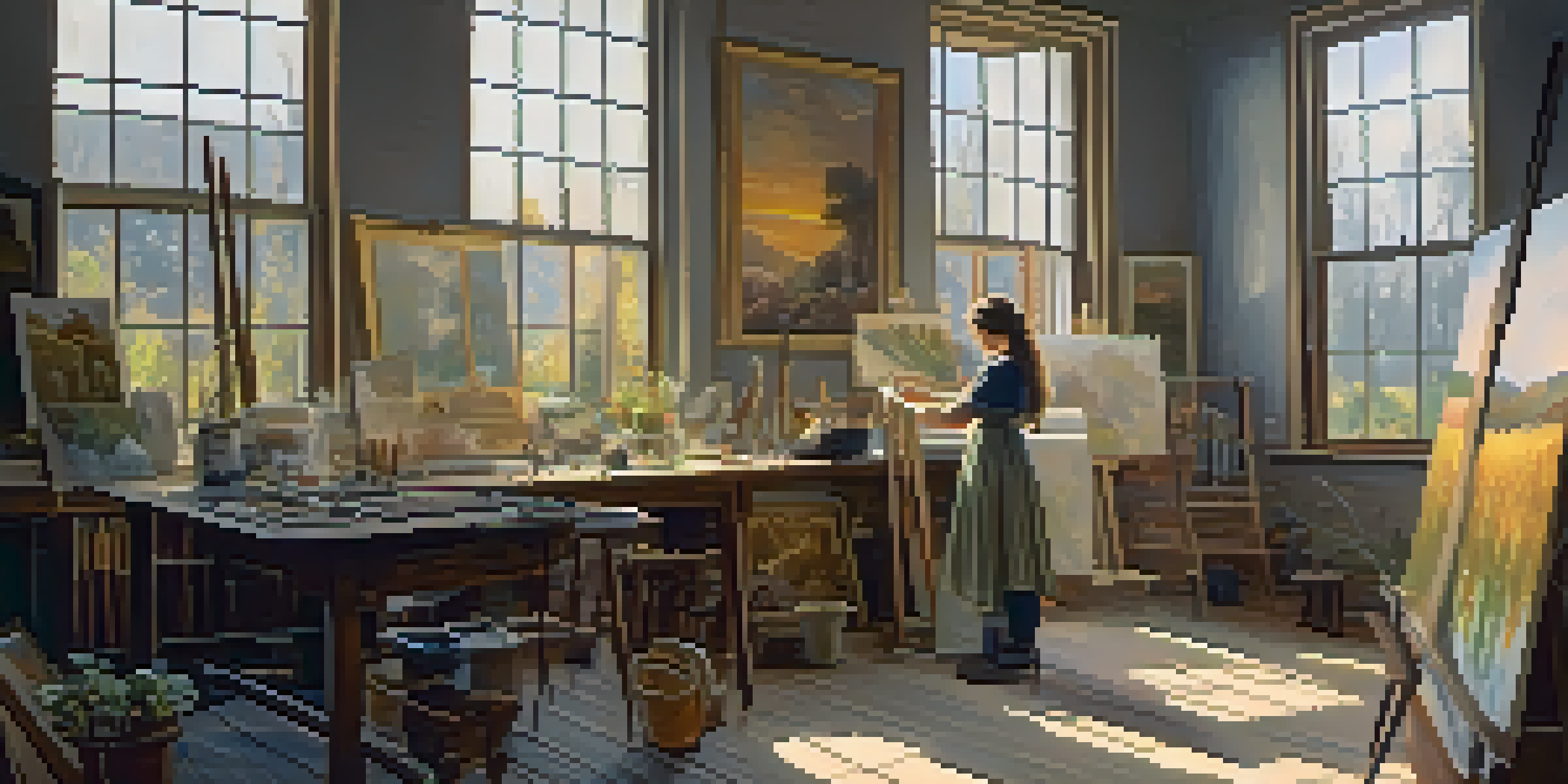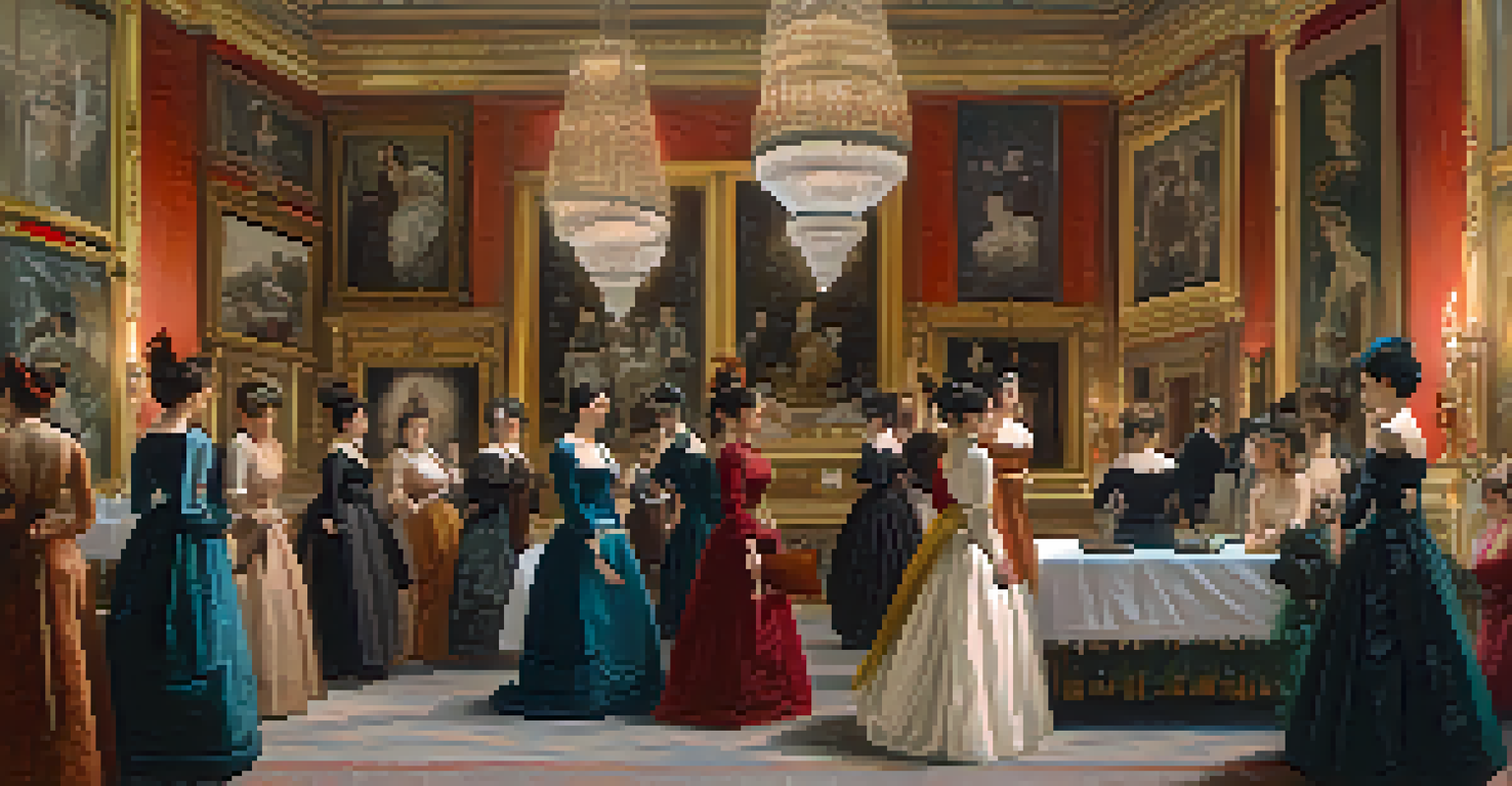The Forgotten Female Artists of the 19th Century

The Historical Context: Women in 19th Century Art
In the 19th century, the art world was predominantly male-dominated, with women often sidelined. Social norms restricted female artists from gaining the same recognition as their male counterparts. Despite these barriers, many women pursued their passion for art, forging paths that would eventually inspire future generations.
Women have been erased from history, and it's time to rediscover their contributions and celebrate their creativity.
During this time, art schools and academies were largely inaccessible to women, forcing them to seek alternative methods of training. Some found mentors among male artists, while others turned to informal workshops or self-study. This determination to create in the face of adversity laid the groundwork for a rich, albeit overlooked, artistic legacy.
The few women who managed to gain prominence often did so by conforming to popular styles or themes, such as domestic life or idealized femininity. However, their contributions were significant, and many of their works reveal a depth of talent and vision that is still relevant today.
Artistic Trailblazers: Notable Female Artists
One of the most notable figures is Rosa Bonheur, a French painter known for her realistic depictions of animals. Bonheur defied societal norms by dressing as a man to gain access to areas where artists could study animals, showcasing her commitment to her craft. Her work gained international acclaim, yet she remains underappreciated compared to her male contemporaries.

Another remarkable artist is Berthe Morisot, a key figure in the Impressionist movement. Morisot's unique perspective as a woman allowed her to capture intimate scenes of domestic life with a delicate touch. While she exhibited alongside famous artists like Monet and Degas, her name often fades into the background of art history.
Women Artists Overcame Barriers
Despite societal restrictions, many female artists in the 19th century pursued their passion and forged paths for future generations.
Lastly, we must mention Mary Cassatt, an American painter who focused on the lives of women and children. Cassatt's work not only challenged traditional gender roles but also emphasized the importance of female experiences. Her contributions to the Impressionist movement significantly shaped perceptions of women in art.
The Struggles for Recognition and Respect
Many female artists faced significant challenges in gaining recognition, often overshadowed by their male peers. Exhibitions and galleries frequently preferred works by men, leading to a lack of visibility for women's art. Despite these hurdles, some women found ways to showcase their talents, creating strong networks and support systems among themselves.
Art is a way of survival. It's a way of expressing what you cannot say with words.
For instance, the establishment of the Women Artists Association in the late 19th century aimed to promote female artists' work and provide a platform for their voices. This initiative was crucial in fostering a sense of community and encouraging women to pursue their artistic endeavors. Yet, even with such support, the road to acceptance was often long and arduous.
The struggle for recognition was not merely about fame; it also involved a fight for artistic freedom and the right to create without societal constraints. Many women used their art to challenge the status quo, pushing boundaries that had long confined them. Their resilience is a testament to their passion and dedication.
The Influence of Feminism on Art
The feminist movements of the late 19th and early 20th centuries began to reshape the landscape of art, allowing female artists to reclaim their narratives. These movements encouraged women to explore themes of identity, gender roles, and societal expectations in their work. As a result, art became a powerful medium for expressing the complexities of womanhood.
Female artists started to gain acknowledgment not only for their technical skills but also for their unique perspectives. This shift marked a new era where women's experiences could be celebrated and explored through art. Artists like Frida Kahlo, who drew from her own life experiences, began to emerge, continuing the legacy of 19th-century female artists.
Feminism Reshaped Art Narratives
The feminist movements of the late 19th and early 20th centuries allowed female artists to reclaim their narratives and explore themes of identity and gender.
This influence of feminism on art laid the groundwork for future generations of women artists, inspiring them to break free from traditional confines. The conversations around gender and art continue to evolve, allowing for a deeper understanding of the contributions women have made throughout history.
Rediscovery of Their Works
In recent years, there has been a resurgence of interest in the works of forgotten female artists. Museums and galleries are beginning to acknowledge these artists' contributions, hosting exhibitions that showcase their talent and influence. This shift not only honors their legacies but also offers new perspectives on art history.
Art historians and scholars are actively researching and writing about these artists, unearthing hidden stories and rediscovering lost masterpieces. This renewed focus allows us to appreciate the diversity and richness of the artistic expressions created by women during the 19th century. Their works often resonate with contemporary themes, proving their relevance today.
Social media platforms and online galleries have also played a significant role in this rediscovery, making art more accessible to a global audience. As conversations around representation and inclusivity grow, the voices of these forgotten female artists are finally being heard, inspiring a new generation of creators.
The Legacy of Forgotten Female Artists
The legacy of 19th-century female artists is one of resilience, creativity, and groundbreaking vision. Their stories remind us that art is not solely the domain of the privileged few but a universal expression of human experience. By acknowledging their contributions, we enrich our understanding of art history and inspire future artists.
These artists have paved the way for women in the arts, demonstrating that passion and talent can transcend societal barriers. Their perseverance in the face of adversity serves as a powerful reminder of the importance of representation in all creative fields. The lessons learned from their journeys continue to resonate today.
Rediscovery of Forgotten Artists
Recent years have seen a resurgence of interest in the works of overlooked female artists, leading to a more inclusive and diverse understanding of art history.
As we celebrate their achievements and contributions, it's essential to keep their stories alive, ensuring that future generations recognize the impact of these remarkable women. By shining a light on their work, we not only honor their legacies but also encourage a more inclusive and diverse artistic landscape.
Conclusion: Honoring Their Impact
In conclusion, the forgotten female artists of the 19th century played an invaluable role in shaping the art world. Their passion, creativity, and determination to create in a restrictive environment are inspiring. By recognizing their contributions, we not only pay tribute to their talent but also challenge the narratives that have historically marginalized women in art.
As we move forward, it’s crucial to continue advocating for equal representation in the arts. This means not only rediscovering the works of these artists but also creating space for contemporary female artists to thrive. Their voices and experiences are essential to the ongoing dialogue about art and society.

Let us celebrate the legacies of these remarkable women, ensuring that their stories are told and their contributions acknowledged. By doing so, we honor their impact on art history and inspire future generations to pursue their artistic passions without limits.